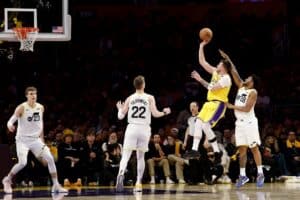College football has kicked off and OddsTrader wants you to be aware of the line movements, and what could cause them, as well as anything else that could signal that something’s afoot. Let’s break it all down so that we can have a successful year in cashing our college football picks for that we need to check our NCAAF odds!

What is Reverse Line Movement?
Let’s cite an actual example of line movement, and subsequently reverse line movement, because the latter cannot happen without the former. On November 30th, 2019, the second-ranked team in the nation, the Ohio State Buckeyes, invaded Happy Valley for a date with the No. 14 Michigan Wolverines.
This was just another chapter in one of college football’s greatest rivalries and the oddsmakers saw an influx of money on the road favorite from Ohio State.
Naturally, the public is always smitten with a favorite, especially one with the sublime pedigree of the Ohio State football program, and the oddsmakers know this all too well. The game opened up with the Buckeyes favored by nine points but with the masses sending it in on Ohio State, this number swelled to as high as 10 on the morning of the game.
However, a funny thing happened to this line as kickoff approached. The number started to move in the other direction, meaning there was someone, or a collection of someones, betting the underdog and taking advantage of what had become a swollen number.
Little by little the number began to fall by half-point increments to where it landed to as low as 7 ½ in some spots.
The scenario above is an example of a reverse line movement. And for those wondering, the Buckeyes crushed the Wolverines, 56-27, proving that the public isn’t always wrong. But why did the line start ticking in the opposite direction when the majority of the bets were on Ohio State? Let’s talk about that next.

What Does Reverse Line Movement Tell You?
When you see a line moving, it tells you that more money is being bet on one side than the other. If the line is moving higher, it means the favorite is getting much of the action but if it moves lower then wagers are coming in on the underdog.
These are corrections made by the bookmaker to attract an even amount of money on both sides.
After all, the bookie’s job is to rake the commission, usually 10 percent, off the top and have no vested interest in the outcome.
That’s the way it should theoretically go for the bookie but most of the time there is an overlay on one side or the other. But the line movement is always caused by money being bet on the favorite or the underdog.
However, when the line begins to move in the opposite direction, we call that reverse line movement and that usually occurs when large bets from a respected bettor, often called a “sharp” or wise guy” in the sports betting nomenclature, come in on the opposite side of the line movement.
You should know that different bookmakers have different strategies for dealing with this. Some will hold the line if the size of the bet doesn’t equal the amount already on the other side.

Those bookies usually take their lumps by not moving off the number because if one sharp is coming in on that side then it won’t be long before others follow suit. Better to move the line, even a half-point, to ward off the sharks who will be doing the same.
The reverse line movement can happen in any game, not just college football, and it can be for several reasons. Oftentimes the sharps know the public will inflate the number on a big favorite and they will wait to let it happen, thereby, taking advantage of a better number being pumped up by the public action.
Sometimes a late injury or inside information can get out and because the sharpest bettors often have many of the best contacts in the business, when information does leak, it leaks to one of their sources, who in turn let’s them know.
But reverse line movement shouldn’t necessarily mean that the side being bet is the right side.
It should only serve as an indicator that something’s happening and, depending on what side you are on, you should consider that when you make your bet. Maybe go for a hedge.
Knowledge is power and that age-old axiom applies to the world of sports betting as well!
Remember that Odds Trader has an entire blog dedicated to enhancing your betting strategy. Go check it out!










